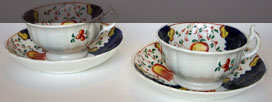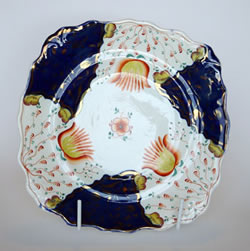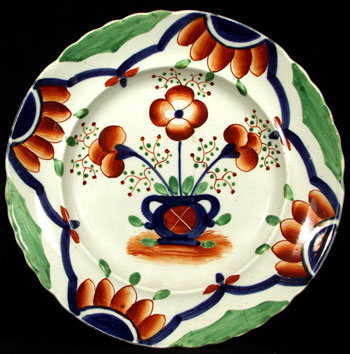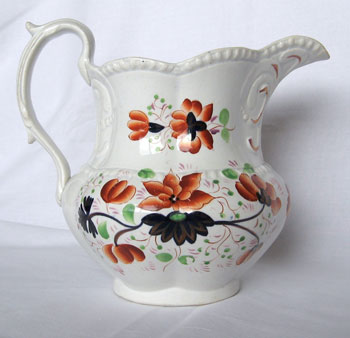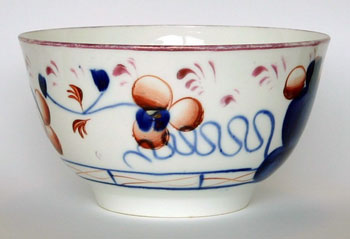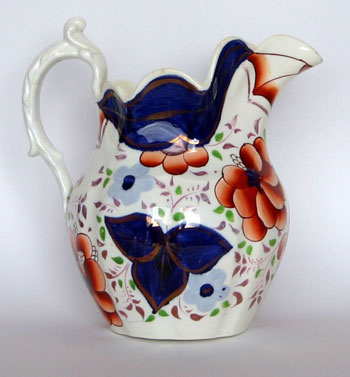Interpreting Ceramics | issue 13 | 2011 Articles & Reviews |
|
||||||||||||
Gaudy Welsh China:History, Technology, Design and Decoration – continued
Jennifer Lewis |
|
||||||||||||
|
Production process The following discussion of production processes draws heavily on the work of Howard Williams. Williams' sources are general ceramic texts and information from his discussions and correspondence with museum curators and other experts. Different combinations of ingredients were used to produce Gaudy Welsh. Finished pieces were called earthenware, cream-ware, ironstone or bone china. Bottom of the range was earthenware; top of the range was bone china. Earthenware, used for much Gaudy Welsh production, was the relatively cheap, durable and serviceable option. There were three stages in the production process. First came the preliminary processing of clay mixtures. This included removing impurities (blunging), sieving (plugging) and mixing of ingredients (wedging). Second the clay was formed into 'bodies'. Gaudy Welsh body shapes are quite numerous and a combination of the methods of throwing, jiggering and jollying, casting and pressing were used to make them. Generally the pieces were hand thrown on the potter's wheel and moulds and pattern tools were used to shape cups and jugs. Handles, finials (ornamental tops) and feet were attached separately. There are several indications that the pieces were intended to be used. Teapots, for example, have working spouts: that is, pierced areas for straining tea. Slop bowls, intended as receptacles for tea leaves, are a generous size.
The third step in production was firing. In the case of Gaudy Welsh, three firings occurred, each at different temperatures. The first firing fused the bodies, and following this any roughness was removed from what was then known as biscuit ware. Biscuit ware provided the 'canvases' for decoration. Underglaze cobalt blue was applied and the pieces were dipped in glaze before the second firing or 'fixing'. The glaze provided a glassy surface which was then painted with copper lustre and enamel colours. The third firing set the lustre and colours.42 Differences and imperfections Even a superficial awareness of steps in the production process helps explain differences in the quality of body, shape and decoration in surviving Gaudy Welsh pieces. For the enthusiast, the various imperfections such as sagging, paint runs, pitting and handles applied askew add to their charm.43
Depending on the sourcing of clay and different recipes used, Gaudy 'bodies' have different thickness and weight, and can vary from opaque to translucent. The differences in firing processes explains the contrast between cobalt blue application which is 'fixed' and the other enamel colours (yellow, orange, green) which may be flaked in surviving pieces. Sometimes in one piece there is different quality body and decoration. Williams notes that on some jugs, probably made in Wales during the 1820s and 1830s, the bodies are faulty while the standard of decoration is excellent.44 Hand painting posed particular technical challenges. Cobalt blue was a dirty brown when applied before the second firing which brought out its blue/purple colour. Enamels and lustre were almost translucent when applied before the final firing. Williams comments that the standard of decoration is testimony to the skill of the workforce, most of whom were women and children working in small factories or their own homes.45 In the transition from 'handicraft' to 'industry', commercial pressure to produce cheaper goods especially affected the standard of decoration. To minimise the number of firings, enamel colours requiring the same temperature were used. That is, within the range of green, orange/rust and yellow. Also there was a gradual reduction of hand processes with simpler designs and economy in use of colours. Small leaves or complex flowers, for example, took longer to paint. The 'Tulip' was one of the few designs made over the entire period (1820 – 1860) and pattern economies may be observed in later pieces.
Gaudy Welsh pieces were hardly ever marked despite availability of copyright protection from 1839 and this makes dating and attribution very difficult.46 Knowledge of differing body shapes, style and decoration helps in identification but as Monica South points out care needs to be taken because factories exchanged moulds and freely copied from each other.47
The limited nature of the literature on Gaudy Welsh does not answer key identification questions. However, Williams has completed basic research and analysis on production dates, places of production and the role of Welsh factories. He cautions that his work is an interim report and that he adopted multiple investigative strategies and often 'the best answer is an educated guess'.48 Dates and places of manufacture Following Williams, the main period of production is considered to be 1820 - 1860. Some authors take the period up to 1890.49 Reproductions manufactured from about 1900 up to the 1930s were generally marked, these being produced by the Staffordshire potteries of Allerton, Blair and Kent. There is a difference of opinion in the literature as to whether reproductions may be regarded as Gaudy Welsh.
Gaudy Welsh was produced in several pottery making regions of Britain including South Wales, the North East (Sunderland, Newcastle and Middlesbrough), the South West (Bristol) and in the Staffordshire Potteries. The majority of the ware was produced in Staffordshire. Williams' estimate of Gaudy Welsh production is 15% Welsh, 80% Staffordshire and 5% other regions.50 Role of Welsh factories The story of the South Wales factories is complex with overlapping changes of owners, family dynasties, rivalries and cross fertilisation of ideas.51 There are no clear answers to questions about the contribution of these factories to Gaudy Welsh production, as may be seen in relation to jugs and tea services, both of which have particular association with Wales and are favourites for display on Welsh dressers. Many Gaudy jugs were made in the 1820s and 1830s and the suggestion is that they were made in Wales for the local market.52 These jugs generally include the earliest patterns. The most common tea service pattern is 'Tulip' which has eight variations. The 'Tulip' pattern is the best known in Wales, and is closely associated with Welsh dressers. However, most tea services were manufactured in the Staffordshire potteries.53 The existence of a small number of marked pieces is most important in terms of the likely role of Welsh factories. Early dated pieces show that Gaudy Welsh was definitely produced in the Cambrian Pottery Swansea between 1831 and 1850 and in the South Wales Pottery in Llanelli from about 1840. The Cambrian Pottery under the direction of Lewis Llewellyn Dillwyn produced a large variety of wares for everyday use. Plates decorated with the Gaudy Welsh 'Pot de Fleurs' pattern are displayed in the Swansea Museum and also in the National Museum of Wales. As noted in Section One, these plates are impressed with the mark 'Dillwyn, Swansea' and were produced 1831 - 1850. 'Pot de Fleurs' Spill vases and jugs are also displayed in Swansea Museum. These vases and jugs are unmarked, but are attributed by Monica South to the Cambrian Pottery.54
The 'Poppy' pattern is also recognised as being in the early Gaudy Welsh style. The South Wales Pottery (Llanelli) produced pouch shaped 'Poppy' jugs under the direction of William Chambers between 1840 and 1855. South includes images of poppy patterned pieces in her Gaudy Welsh Visual Reference Books attributed to the 'South Wales Pottery'.56 In summary, the quality and cost of Gaudy Welsh china was determined by the clay, the forming processes and the type of decoration. The survival of 'Pot de Fleurs' and 'Poppy' pieces, and early octagonal jugs give an intriguing snapshot of early Welsh contribution. With the exception of Williams' work, documentation establishing the role of Welsh factories is minimal and patchy. From his account, it appears likely that production started in Wales and was later copied, mass produced and promoted by the Staffordshire Potteries for a developing export market.57
The category of 'the aesthetic' is a complex question that has become controversial on a number of levels. Discussion on what is aesthetically pleasing and how artworks give people pleasure tends to be more broadly evaluated in current times.58 Though Gaudy Welsh has less sophisticated drafting and workmanship than fine china, the ware is visually appealing because of its decorative style and colourful hand-painted decoration. Some time ago Laidacker wrote that in terms of value, it is the decoration of pieces that is important, not the maker or even the article itself.59 Decorative style 'Chinoiserie' is the term coined in the nineteenth century for a decorative style that takes its inspiration from Asian art and design. The Chinoiserie style contributed an array of decorative motifs and a new visual vocabulary to the British ceramics industry.60 British porcelain manufacturers copied 'oriental' designs extensively and factories, such as Royal Worcester, were well known for producing Chinoiserie decorated china61. Mason and Ridgeway factories produced tableware in similar designs. Decoration imitating Asian styles was considered particularly appropriate for tea wares because of the East Asian origins of both tea and porcelain.62 Gaudy Welsh design, patterns and colour is part of this fashion. Specifically it is related to Japanese 'Imari', a highly decorated and brightly coloured ware. The term 'Imari' derives from the seaport located near the porcelain factories at Arita in Japan from which porcelain was exported. 'Imari' was largely an export ware and had limited consumption in Japan. Imari designs were often based on textile patterns, becoming especially sumptuous when transferred to ceramics as a bold decorative scheme.63 Imari colours, underglaze blue in combination with iron red and gold overglaze and green, yellow and brown/black enamels are very similar to Gaudy Welsh. Gaudy Welsh designs are vivid and predominantly resemble 'oriental' depictions of flowers such as anemones, poppies, tulips, roses, peonies and cherry blossom. Some designs are abstract with vertical stripes or lattices. Within designs there are a number of decoration similarities. Panels, cartouches, fences, grape leaves and flower petals are common.
Gaudy Welsh is notable for its large number of patterns and variation of design within patterns. In 1978, Howard Williams estimated the number of patterns as being 'maybe as many as 300'64 Twenty-five years later, Monica South gives an estimate of 460.65 This may appear to be a large number, but many individual patterns were short lived. Also, some patterns – 'Grape', 'Hexagon', 'Tulip' and 'Vine' - had more than one design, and 'Tulip', one of the most common patterns, has eight variations of design. Different executions of the one pattern are not identical as they were individually outlined and hand painted. Pattern names Gaudy Welsh pattern names are an aspect of production that has caused considerable confusion. According to Robert Pugh patterns were not given names at the time of manufacture and the naming of patterns has accelerated in contemporary times, particularly in the United States, to enable the ware to fit more easily into a collectors market.66 Many patterns have been named after what the design represents, such as particular flowers. Other patterns have been named after villages and towns in Wales. Therefore the link between pattern names and whoever named them may be quite arbitrary and cannot inform on matters such as design trends. It appears that Williams, author of Gaudy Welsh China was partially responsible for some of this 'cataloguing' and the influence of his North Welsh connections is reflected in the names of patterns such as 'Bethesda', 'Snowdonia', 'Deiniolen', 'Llanrug', 'Capel Curig' and 'Caernarfon'.67 Pattern numbers placed on the underside of pieces are a different matter altogether. It may be that patterns were initially known by numbers that were placed on the bottom of cups and saucers, ranging from 2 to 4011.68 It is not likely that different manufacturers shared the same numbers for their versions of the same or similar patterns. Colours A major characteristic of Gaudy Welsh is the colour palette which consists of cobalt blue, copper lustre and various shades of green, yellow, orange and pink. As South points out there is a cohesive quality about the ware in that the kaleidoscope of colours is very consistent.69 The major colours always appear and usually dominate the design. Gaudy Welsh stands out in the crowded world of collectables and this is largely because of its vibrant colours. Shuman provides an excellent description of colouration,
In summary, for an appreciation of Gaudy Welsh decorative style, patterns and colours, words are not adequate. Take, for example, Shuman's description of the 'Drape' pattern.
The vivid, bold and balanced qualities of the 'Drape' pattern are better appreciated in the following image.
It comes as no surprise that Shuman, summing up the appeal of Gaudy Welsh, writes that it holds a hypnotic trance over the collector,
Conclusion This article is firstly about the literature of Gaudy Welsh, secondly about the characteristics of the ware itself and thirdly about its social and cultural contexts. The significance of Gaudy Welsh rests mainly within the social/cultural and the distinctive quality of its design and decoration. The idea for the article grew out of my response to unpacking a tea service in my home in Australia, defining moments experienced as cups and saucers were revealed from bubble wrap and tissue paper. So began my search for information. During the search it became clear that, apart from some basic reference texts and museum displays, there was little documentation available. An immediate discovery was that the china my family had known as 'Swansea Cottage' is now called 'Gaudy Welsh'. Further exploration may uncover more information on the earliest uses of these names. This article is heavily reliant on Williams' Gaudy Welsh China for aspects of technology and manufacture. The questions around accurate dating, attribution and the role of Welsh factories, in particular, are intriguing. Clearly Welsh factories were significant in producing early Gaudy Welsh pieces. A more extensive search of contemporary and primary sources may retrieve further information on this aspect and also on marketing, exporting and consumption patterns. Cheap and comparatively simple to make, Gaudy Welsh answered the need for something bright and cheerful in the lives of ordinary people. The ware is also interesting because it is likely that pieces were painted in people's homes or in small factories scattered throughout Britain. Further research may reveal details about the decorators and the painstaking task of hand painting. There is a continuing interest in Gaudy Welsh by collectors and enthusiasts. It is prominently displayed in Welsh museums and many more pieces are conserved in museum storage. In Welsh and American homes it retains its place on display along with other items of china collected by families generations ago. Acknowledgement This article is an updated version of a research report completed for the Cumming Ceramic Research Foundation, Ontario, Canada. The research report was supported by a grant from the Foundation. Top of the page | Download Word document | Next Notes To return to the article click the relevant note number 42 Some authors consider that lustre and enamels would have required firing at different temperatures, and that what is seen as ‘lustre’ may in fact be thin inexpensive gilding. See Godden, Godden’s Guide to Ironstone, Stone and Granite Wares, p. 246. 43 South, Gaudy Welsh a Visual Reference Book, p. 12. 44 Williams, Gaudy Welsh China, p. 114. 45 Williams, Gaudy Welsh China, pp. 59 -73. 46 For suggestions of why there is no manufacturer mark on Gaudy Welsh see Williams, Gaudy Welsh China, p. 39-40. 47 Williams, Gaudy Welsh China, p. 6. 48 South, Gaudy Welsh, a Visual Reference Book, volume 2, p. 11. 49 South, Gaudy Welsh a Visual Reference Book, p. 6. 50 Williams, Gaudy Welsh China, p. 50. 51 Lynne Bebb, Welsh Pottery, Risborough, Shire Publications, 2004; Hughes, Welsh China; Pugh, Welsh Pottery. 52 Williams, Gaudy Welsh China, p. 114. 53 South, Gaudy Welsh a Visual Reference Book: p. 13. 54 South, Gaudy Welsh a Visual Reference Book, pp. 38, 44 and 220. 55 See www.swanseaheritage.net/ for various articles and fact files on Cambrian pottery jugs. 56 South, Gaudy Welsh a Visual Reference Book, p.38; South, Gaudy Welsh, a Visual Reference Book, volume 2, p.103 57 Williams, Gaudy Welsh China, p, 48. 58 For a full discussion see Harris, The New Art History. 59 Laidacker, Anglo-American China Part II, p .x. 60 Cains, Carol and Martin, Matthew, Chinoiserie: Asia in Europe 1620 – 1840, Melbourne, National Gallery of Victoria, 2009, p. 15. 61 According to Shuman, Royal Worcester was the first manufacturer of Gaudy Dutch. Shuman, The Collector’s Encyclopedia, p.13. 62 Cairns and Martin, Chinoiserie, p.13. The great rise in tea drinking in the nineteenth century, and its connection with aspirational values, created the need for tea services – teapots, cups and saucers, sugar bowls, slop bowls and milk jugs. For an introduction to this topic see Vincentelli, Talking Pots, p18 and Caroline Prosser ‘Breakfast China’ Cyfarthfa Castle display notes, 1994. 63Japan Patterns, www.keele.ac.uk accessed 6 April 2010. 64Williams, Gaudy Welsh China, p. 114. 65 South, Gaudy Welsh, a Visual Reference Book, volume 2, p. 10. 66 Pugh, Welsh Pottery, p. 57. 67 Williams. Ieuan, ‘My loose connection with Gaudy Welsh’, p. 32. 68 See South, Gaudy Welsh, a Visual Reference Book, volume 2, p.10. South recommends caution as numbers may have been incorrectly transcribed, may be workman’s tally mark and numbers painted on underside of jugs may refer to mould of the jug rather than pattern number. 69 South, Gaudy Welsh, a Visual Reference Book, p. 12. 70 Shuman, The Collector’s Encyclopedia, pp. 97-8. Yellow, however, is used on the earliest and most popular pattern the ‘Tulip’. 71 Shuman, The Collector’s Encyclopedia, p. 134. 72 Shuman, The Collector’s Encyclopedia, p. 98. Top of the page | Download Word document | Next Bibliography Arman, David. ‘Let Me Introduce You to Sam Laidacker’, The China and Glass Quarterly’, vol 1, no 1, Jan/Feb 1997, pp. 41-44. Bebb, Lynne. Welsh Pottery, Risborough, Shire Publications, 2004. Cains, Carol and Martin, Matthew. Chinoiserie: Asia in Europe 1620 -1840, Melbourne, National Gallery of Victoria, 2009. Collector Books. ‘Meet the Authors’, John Shuman III, www.collectorbooks.com (accessed 23 March 2010) Collet, Penelope. ‘A Commentary on Women Creating Spaces in Welsh Visual Culture’, Visual Culture & Gender, vol 3, 2008: pp. 91-99. Copeland, Robert. ‘Pottery Manufacturing Processes of the Eighteenth and Nineteenth Century’, in Gray, Jonathan (ed), Welsh Ceramics in Context, Part 1, Swansea, Royal Institution of South Wales, 2003, pp. 39-52. Dahn, Jo. ‘Mrs Delany and Ceramics in the Objectscape’, Interpreting Ceramics, Issue 1. www.interpretingceramics.com/issue001/delany/delany.htm (accessed 27October 2009) Dale, Gloria. ‘Gaudy Welsh and Gaudy Dutch’, The Antique Collector, September 1984, pp. 89-91. Glamorgan Antiques. ‘Introduction to Gaudy Welsh’. www.glamorganantiques.co.uk (accessed 5 November 2009) Godden, Geoffrey A. Godden’s Guide to Ironstone, Stone and Granite Wares, Woodbridge, Antique Collectors Club, 1999. Gray, Jonathan (Ed). Welsh Ceramics in Context, Part 1, Swansea, Royal Institution of South Wales, 2003. Gray, Jonathan (Ed). Welsh Ceramics in Context, Part 2, Swansea, Royal Institution of South Wales, 2005. Harris, Jonathan. The New Art History: a Critical Introduction, London, Routledge, 2001. Hughes, Peter. Welsh China. An Illustrated Handbook, Cardiff, Amgueddf Genedlaethol Cymru - National Museum of Wales, 1972. ‘Japan Patterns’. www.keele.ac.uk/marketing/RavenMason/JapanPatterns (accessed 6 April 2010). Laidacker, Sam. Anglo-American China, Part 1, Second edition. Bristol Pennsylvania, Sam Laidacker, 1954. Laidacker, Sam. Anglo-American China, Part II, Bristol Pennsylvania, Sam Laidacker, 1951. Nance, Ernest Morton. The Pottery and Porcelain of Swansea and Nantgarw, London, Batsford, 1942. ‘Pot De Fleurs’ - Swansea Heritage Net fact file – History in Pictures, www.swanseaheritage.net/article/gat.asp?ARTICLE_ID-94 (accessed 23 March 2010) Prosser, Caroline. The Ceramics of Cyfarthfa Castle – a Rough Guide, Cyfarthfa Castle Museum display notes, 1994. Prosser, Caroline. Breakfast China, Cyfarthfa Castle Museum display notes, October 1994. Proudlove, Christopher. ‘Antique Welsh pottery, gorgeous Gaudy relics of a lost art’, www.writeantiques2.blogspot.com (accessed 5 November 2009) Pugh, Robert. Welsh Pottery, Bath UK, Towy Publishing, 1995. Shuman, John III. The Collector’s Encyclopedia of Gaudy Dutch and Welsh, Paducah KY, Collector Books, 1991. South, Monica A. Gaudy Welsh: a Visual Reference Book, Abergavenny, Monica South, (photographs David Glew), 1997. South, Monica A. Gaudy Welsh, a Visual Reference Book, volume 2, Abergavenny, Monica South, (photographs David Glew), 2002. Sparks, Rosemary. ‘Gaudy Welsh’, Antiques and Collecting Magazine, February 1995, pp. 40-41 and 56-57. Vincentelli, Moira. Talking Pots, Aberystwyth, University College of Wales, 1992. Vincentelli, Moira. ‘Welsh Dressers and Ceramic Display’, Planet, The Welsh Internationalist, 100, August/Sept 1993, pp. 32-37. Vincentelli, Moira. ‘Artefact and Identity: The Welsh Dresser as Domestic Display and Cultural Symbol’ in Our Sisters’ Land, edited by J. Aaron, S. Betts, T. Rees and M. Vincentelli, Cardiff, University of Wales Press, 1994, pp. 228-241. Vincentelli, Moira. ‘The Welsh Dresser: a Case Study’, Interpreting Ceramics, 1. www.interpretingceramics.com/issue001/delany/delany.htm (accessed 27 October 2009) Williams, Howard Y. Gaudy Welsh China, Des Moines Iowa, Wallace Homestead Book Company, 1978. Williams. Ieuan. ‘My Loose Connection with Gaudy Welsh’, 2/55 Gwynedd Roots, Autumn/Winter 2008: pp. 30–32. Websites www.museumwales.ac.uk (National Museum of Wales) www.gtj.org.uk (Gathering the Jewels) www.swanseaheritage.net (Swansea Heritage Net) |
|||||||||||||
© The copyright of all the images in this article rests with the author unless otherwise stated |
|||||||||||||
Gaudy Welsh China • Issue 13 |
